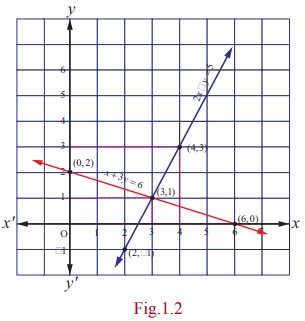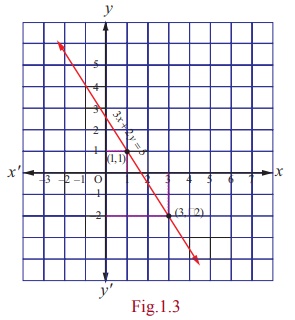Applications of Matrices: Solving System of Linear Equations - Solution to a System of Linear equations | 12th Mathematics : UNIT 1 : Applications of Matrices and Determinants
Chapter: 12th Mathematics : UNIT 1 : Applications of Matrices and Determinants
Solution to a System of Linear equations
Solution to a System of Linear equations
The meaning of solution to a system of linear equations can be
understood by considering the following cases :
Case (i)
Consider the system of linear equations
2x - y = 5 , ... (1)
x + 3y = 6 . ... (2)
These two equations represent a pair of straight lines in two
dimensional analytical geometry (see the Fig. 1.2). Using (1), we get
x = [5 + y] / 2 (3)

Substituting (3) in (2) and simplifying, we get y = 1.
Substituting y = 1 in (1) and simplifying, we get x = 3 .
Both equations (1) and (2) are satisfied by x = 3 and y = 1.
That is, a solution of (1) is also a solution of (2).
So, we say
that the system is consistent and has unique solution (3,1) . The point (3,1)
is the point of intersection of the two lines 2x - y = 5 and x + 3y
= 6 .
Case (ii)
Consider the system of linear equations
3x + 2 y = 5 , ... (1)
6x + 4 y = 10 ... (2)
Using equation (1), we
get
x = [5 - 2 y] / 3 ... (3)

Substituting (3) in (2) and simplifying, we get 0 = 0.
This informs us that equation (2) is an elementary
transformation of equation (1). In fact, by dividing equation (2) by 2, we get
equation (1). It is not possible to find uniquely x and y with just a single
equation (1).
So we are forced to assume the value of one unknown, say y = t
, where t is any real number.
Then, x = [5 - 2t] /3. The two equations (1) and (2) represent
one and only one straight line (coincident lines) in two dimensional analytical
geometry (see Fig. 1.3) . In other words, the system is consistent (a solution
of (1) is also a solution of (2)) and has infinitely many solutions, as t can
assume any real value.
Case (iii)
Consider the system of linear equations
4x + y = 6 , ... (1)
8x + 2 y = 18 . ... (2)
Using equation (1), we get
x = [6 – y] / 4 ... (3)

Substituting (3) in (2) and simplifying, we get 12 = 18 .
This is a contradicting result, which informs us that equation
(2) is inconsistent with equation (1). So, a solution of (1) is not a solution
of (2).
In other words, the system is inconsistent and has no solution.
We note that the two equations represent two parallel straight lines
(non-coincident) in two dimensional analytical geometry (see Fig. 1.4). We know
that two non-coincident parallel lines never meet in real points.
Note
(1) Interchanging any two equations of a system of linear
equations does not alter the solution of the system.
(2) Replacing an equation of a system of linear equations by a
non-zero constant multiple of itself does not alter the solution of the system.
(3) Replacing an equation of a system of linear equations by
addition of itself with a non-zero multiple of any other equation of the system
does not alter the solution of the system.
Definition 1.8
A system of linear equations having at least one solution is said
to be consistent. A system of linear
equations having no solution is said to be inconsistent.
Remark
If the number of the equations of a system of linear equations
is equal to the number of unknowns of the system, then the coefficient matrix
A of the system is a square matrix. Further, if A is
a non-singular matrix, then the solution of system of equations can be found by
any one of the following methods : (i) matrix inversion method, (ii) Cramer’s
rule, (iii) Gaussian elimination method.
Related Topics